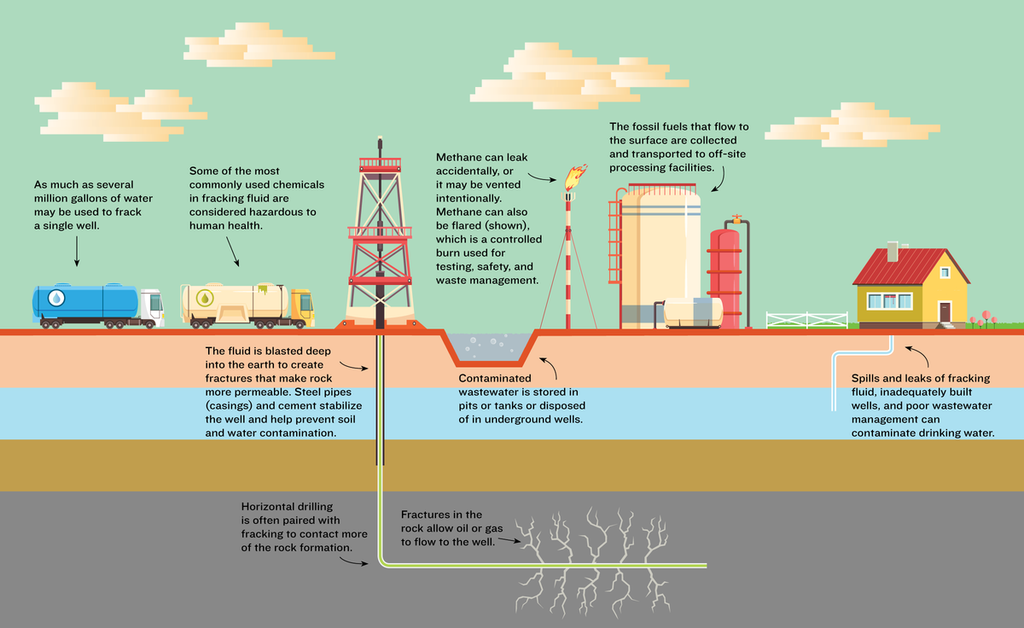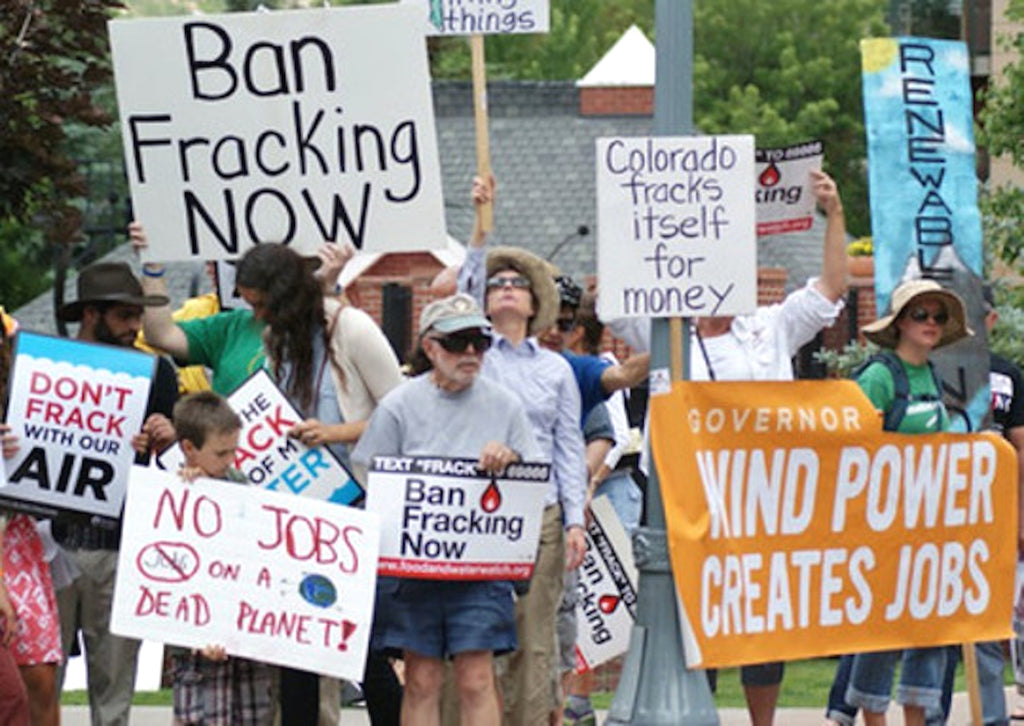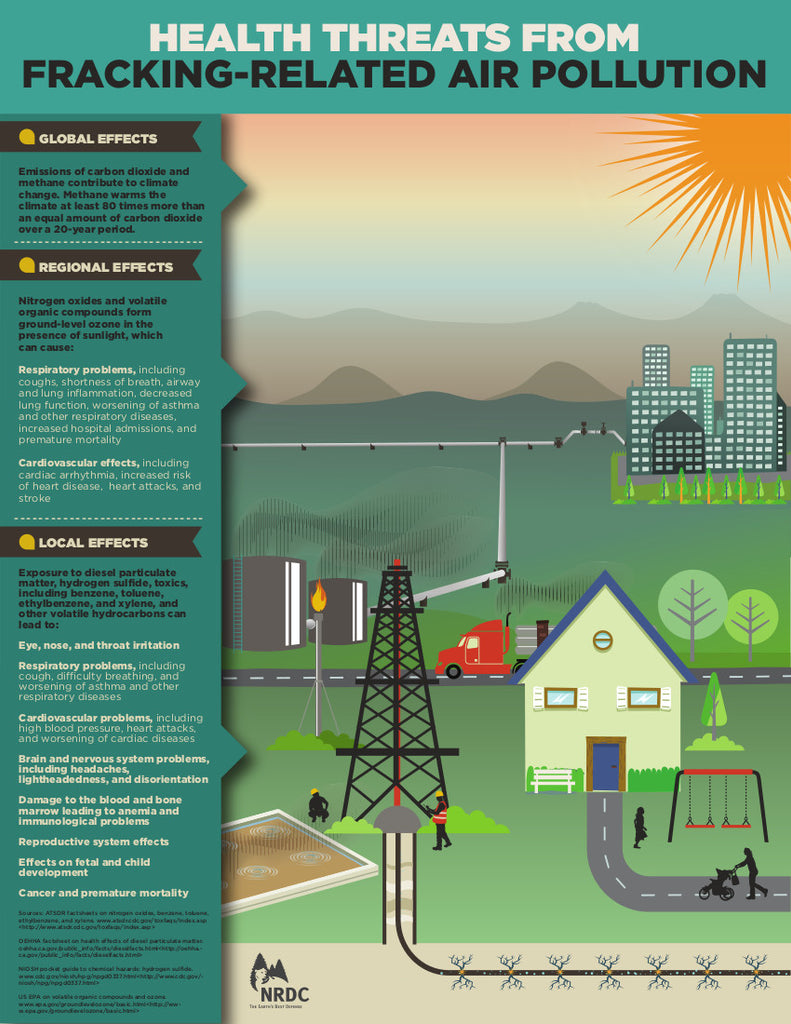“We have to take the responsibility of making sure that the planet we leave our children and grandchildren is a planet that is healthy and habitable. That is more important than the fossil fuel industry.” ~Bernie Sanders
There's been a lot of talk about fracking lately with Senator Sanders and Alexandria Ocasio-Cortez's recent Fracking Ban Act proposed earlier this year, which has a goal to eliminate fracking by 2025. Because restricting fossil fuels is crucial in the fight to alleviate the climate crisis, I wanted to take a moment to breakdown the facts!
What Is Fracking?
Hydraulic fracturing, or fracking, involves pumping large quantities of water, sand and chemicals into tight rock formations to create fractures that allow trapped gas and oil to release.
Over the past 15 years, fracking has become the dominant method of oil and gas extraction in the US, making us a global leader in natural gas and oil production. Hundreds of thousands of new wells have been drilled in the past decade alone, with fracking taking place in nearly 30 states. But, this fracking boom comes at a high cost due to its negative impacts on public health, environmental safety, and climate change.
Additionally, fracking has misleadingly been marketed as a “bridge fuel” to move us away from coal and oil to more renewable energy sources, such as wind and solar power. While it has helped replace dirtier coal for electricity generation, this long-held argument by the fracking industry has further increased our dependence on fossil fuels, and has only delayed transitions to readily available renewable alternatives, causing increased harm to the climate.
How Does Fracking Impact the Environment + Our Health?

More than 17 million people in the US live within a mile of active fracking wells. According to the Physicians for Social Responsibility, “living near fracking sites adversely affects health and pregnancy, raising risks for preterm birth and low birth weights, as well as asthma, skin and sinus conditions, and headaches.” Not to mention the devastating effects fracking has on our water, air quality, public lands, and wildlife.
Let's take a deeper look at 9 adverse impacts of fracking:
1. Carbon Emissions + Climate Change
Remember the IPCC report where hundreds of scientists warned that if humanity wants to limit warming this century to 1.5 degrees Celsius, countries would need to cut their global emissions in half by 2030, and reach net-zero emissions by 2050? Well, the US is currently responsible for the highest share of cumulative global greenhouse gas emissions of any country, and is the second largest emitter in the world after China. At the rate that we are currently going, we won’t reach zero emissions until 2100—50 years too late!
But, how is this related to natural gas production? Six years of intensive research from the Environmental Defense Fund revealed methane emissions from US oil and natural gas production are almost 60% higher than government estimates. 60%! To give you an idea of what that means: methane traps more than 25 times the amount of heat compared to carbon dioxide over a 100 year period. To make matters worse, methane leaked from gas wells can stay in the atmosphere for a decade.
So, not only has fracking delayed our transition to renewable energy, it has accelerated methane levels in the atmosphere, further increasing warming for future generations. And, while the fracking industry would like us to believe that natural sources make up the majority of the methane in the atmosphere, new research published in Nature suggests otherwise, mostly attributing it to fracking. Other studies have also linked more than half of the global increase in methane emissions over the past 10 years to fracking in the US alone. Yet, the fracking industry will continue to argue that it's a cleaner alternative, which brings me to our next point!
2. Leaks + Spills
Who can tell me the main component of natural gas? If you said methane, you’re right! While it produces less carbon dioxide than coal when burned, getting natural gas out of the ground and transporting it to its final destination releases as much methane gas as burning it, which is still pretty bad! Additionally, if methane leaks—as it often does during fracking—it becomes a potent, climate change driving, greenhouse gas as we discussed above.
Spills and leaks can occur throughout the fracking process due to both human error and equipment failure. If oil and gas wells are constructed poorly, intense temperature changes and pressure fluctuations can also damage wells, allowing gas, oil, and fracking fluids to leak. Some spills are known to have reached surface water resources, according to the EPA. For instance, close to 133 drinking water contamination cases in Texas and Pennsylvania were due to faulty well construction. It doesn’t help the situation that leaks are hard to track.
According to Cornell University Fracking Researcher Robert Howarth, “Natural gas production in the United States is leaking somewhere in the neighborhood of 3.5 percent of the gas we produce into the atmosphere which is, you know a relatively small amount of gas if you think about it. Most of it is getting to market. But that 3.5 percent is enough to do severe damage to the climate.”
Regardless of how much gas is leaking, the fact that people are left with methane-filled drinking water is completely unethical. Ask yourself, would you be willing to drink a glass of water if it was only 3% poison? Exactly! In the same way, the 3.5% of leaks are enough to damage our bodies and the environment!

3. Chemical Exposure
Similar to the ingredients in skincare products, companies are not required by federal law to identify the chemicals they feed into the ground while fracking, which as we know is never a good sign! Because fracking occurs in tight rock formations, various chemicals are needed to access the oil and gas trapped inside.
Between 2005 and 2013, the EPA identified 1,084 different chemicals used in fracking fluids, many of which are considered toxic to humans. Researchers at Yale’s School of Public Health reported that 157 of 240 chemicals they analyzed—including arsenic, benzene, lead, formaldehyde, mercury, and chlorine—were associated with developmental and reproductive toxicity, as well as cancer risks. Even more disturbing, it’s unclear the impacts most fracking chemicals truly have on our health, as complete information about their associated risks are not available for two-thirds of the chemicals used.
4. Water Contamination
So, where exactly do these health-harming chemicals go? Billions of gallons of toxic wastewater, and hazardous mixtures of fracking fluids that flow back to the earth’s surface, are created yearly by the oil and gas industry, posing threats to both surface water and underground aquifers that supply drinking water. Fracking wastewater also pollutes countless rivers and streams, often contaminating food supplies in areas where farming and fracking overlap. Not to mention, improper waste management practices, spills and leaks of toxic fracking fluids, and injection of fluids into poorly built wells, which further aggravate the problem.
Because fracking operators can’t fully control or determine where fractures will occur, they can extend deeper than intended, unknowingly connecting with local wells that nearby residents rely on for drinking water. According to the EPA, it’s also unclear how close fractures are to underground rocks that transmit and contain groundwater.
In the Wind River Basin of Wyoming, for example, the same rock formation that contains natural gas also provides drinking water for the nearby town of Pavillion, and has been poisoning their water for years. But thanks to the political influence the fracking industry has on the local and national governments, and their exemption from laws that protect our air and water, the residents of Wyoming continue to suffer the consequences. And, this is just one of many examples.
"Everyone in Wyoming knows that groundwater is probably our most important resource," says Hydrogeologist Sue Spencer. "To let this go on for 10 or 15 years and these people still have no water except for a few bottles delivered once a week is just not right.”
5. Air Pollution
Along with contaminating our water, fracking also releases dangerous toxins into the air, including benzene, toluene, ethylbenzene, and xylene, as well as nitrogen oxides and volatile organic compounds, which produce smog when combined. Researchers estimated that the amount of smog-forming compounds produced from oil and gas operations yearly was equivalent to the emissions of 100 million cars. 100 million!
And, this doesn’t come without significant side effects. Respiratory illness, neurological problems, endocrine (hormone) disruption, birth defects, cancer, cardiovascular damage, and premature mortality are the associated health effects from exposure to these toxic air pollutants. And, according to the National Resource Defense Council, “industry workers face even greater risks from on-site exposure to toxic chemicals and other airborne materials, including silica (the main component of frac sand), which can lead to lung disease and cancer when inhaled.” The fracking industry's complete disregard for their own workers' health is a whole other issue, one that is not surprising given their track record.
6. Water Supply Depletion
Not only does fracking pose a threat to safe drinking water and the air we breathe, it also depletes local water supplies due to the massive volume of water it requires. Anywhere from 1.5 million to 16 million gallons of water can be used to frack a single well, depending on the type of well and rock formation. Because this water is taken from surface and groundwater reserves, it’s typically fresh and can largely strain resources needed for local drinking water and agriculture, as the water is too contaminated to be reused after fracking is completed.
It’s predicted that fracking’s water footprint can increase by 50 times in some regions over the next 10 years. With climate change already stressing many regions’s freshwater supplies, the implications of this footprint are dire.
7. Earthquakes
So, what happens to all of that contaminated water? It gets injected deep underground, exerting pressure that can actually cause fault lines to shift, resulting in human-induced earthquakes!
To put this into perspective: between 1973 and 2008, the central and eastern United States averaged 25 earthquakes of magnitude 3 or higher yearly. That number increased to 1,000 earthquakes (a 40% increase!) in 2015 alone, with Oklahoma and Ohio experiencing a dramatic rise, thanks to booming natural oil and gas production and the need to dispose of the accompanying wastewater. Given how rare earthquakes are in many of these areas, states are not properly equipped to handle this unnatural seismic activity, not to mention, the damage caused to local homes and infrastructure.
8. Nature + Wildlife Degradation
If all of this wasn’t bad enough already, humans aren’t the only ones being affected by the toxic effects of fracking. When wastewater isn’t injected back into the ground, it’s sprayed onto nearby forest land killing much of what it touches. In West Virginia, more than half of the trees in the area died within two years of being sprayed.
Much of the infrastructure needed for natural oil and gas production also eats into forests and wildlife habitats having adverse effects on local animals. Fracking operations have taken over half of local deer’s winter habitat that’s critical for their survival in Northwestern Colorado, alone. And, we’re only beginning to fully understand its effects on wildlife.
9. Disregard for Poor + Minority Populations
Last, but certainly not least, is the complete disregard for poor and minority populations, who often face the brunt of climate change and corporate negligence. For instance, researchers found in Pennsylvania, fracking wells are disproportionately located in poor communities. Their analysis showed that areas with potentially exposed tracts had a significantly higher percent of people living below poverty level than areas with non-exposed tracts in 7 out of 9 analyses. Clusters of gas wells were also found to disproportionately impact the poor, elderly, and those with lower education in West Virginia, as well as children in Ohio.
The same rings true for the poor and minorities in South Texas, where studies found they were twice as likely to be near wastewater wells and suffer health consequences. Not to mention California, where 95% of the state’s fracking takes place in Kern County, an agricultural region, where the community is largely immigrants, people of color, and low income. This raises huge environmental justice concerns, on top of the negligence we’ve already discussed, as people under the poverty line have less access to information about the dangers of fracking, as well as a decreased ability to move out of these areas and to get the medical care they need due to the deadly toxins they are often, unknowingly, exposed to.
What Is the Fracking Ban Act + Why Does It Matter?

“Not only is natural gas dangerous and destructive, it’s increasingly unnecessary. We do think there should be a national ban on fracking.” ~ Michael Brune, executive director of the Sierra Club
The Fracking Ban Act will revoke fracking permits within 2,500 feet of homes and schools, with a nationwide ban beginning January 1, 2025. The law would also prohibit federal agencies from issuing permits for new fracking projects or infrastructure, and would provide a transition for working families in the fracking industry by establishing a Just Transition Committee, led by the Department of Labor, to help ensure the health and prosperity of natural gas and oil producing regions.
Why It Matters
The fracking industry is gearing up for an enormous expansion. According to a recent report from Food & Water Watch, “more than 700 fracked gas infrastructure projects have recently been built or proposed for development.” On top of the environmental destruction, public health concerns, and racial discrimination discussed above, here are six more reasons this bill is urgently needed, summarized from their report:
- Small Declines In Greenhouse Gas Emissions Are Not Enough! In the last 10 years, emissions from coal and gas plants have declined by 10%. At this rate of decline, we will not reach zero greenhouse gas emissions until 2100, 50 years later than what scientists around the world call for to save the earth!
- Increasing Natural Gas Production Keeps Us Off Clean Energy! The more natural gas plants that open, the less space we have for clean renewable energy, not to mention natural gas plants have lifespans of 40-50 years. Significant carbon reductions are impossible if even 11% of the grid is powered by natural gas.
- Gas Corporations Care About Their Financial Stake, Not Our Health! $30 trillion in profits are anticipated globally by fossil fuel corporations by 2100. Exxon alone has $20 billion in profit annually, mostly from fossil fuels, so it's in their benefit to ignore the facts.
- Since the Industrial Revolution, Methane Is Responsible For A Third of the Earth’s Warming! Atmospheric methane levels were steady for about a decade until 2007, after which they started to rise; a trend reversal that closely corresponds to the fracking boom.
- Fracking Costs Us More Than It Saves! Renewables are a cheaper option than natural gas over their lifetime. A single megaton of methane emitted into the atmosphere can create enough ozone to cause $132 million in damages to forestry, agriculture and public health, as well as hundreds of premature deaths annually. But, investors tend to commit to natural gas in the short term because power plants have lower upfront costs.
- Fracking is Seriously Unregulated by Federal Law! Loopholes created in Congress exempts oil and gas companies from the Safe Drinking Water Act, Clean Water Act, Clean Air Act, Resource Conservation & Recovery Act, and the National Environmental Policy Act. The Trump administration continues to aggressively open up more public land to fracking, while proposing rollbacks of existing regulations on oil and gas operations. So, they are not held accountable for any of the public health issues and environmental destruction they cause!
What You Can Do to Help!

- Use Your Voice. Fracking has been banned in 3 states with the help of environmental justice organizations and the people’s demand. Contact your local congressman. Sign Food & Water Watch’s petition for individuals and businesses to say no to fracking in Illinois, and other states!
- Spread the Word. Share these petitions and what you’ve learned with others. Use social media as a tool to spread awareness about what’s at stake. If fracking has negatively impacted your community or someone you know, encourage them to share their stories with the media and environmental justice organizations to help spread the word.
- Vote Green. Stricter federal regulations of the natural gas industry are needed to protect our health and the environment. While some states (New York, Maryland, and Vermont) have banned fracking altogether, others are still taking steps to improve fracking oversight. Know where your local and national candidates stand on fracking, and use your vote to make a difference!
- Get Involved. Get involved in local climate working groups, such as Americans Against Fracking coalition, which brings together organizations to call with one voice for a ban on fracking, or by participating in the Global Frackdown, an international day of action spearheaded by Food & Water Watch to unite organizations from around the world to call on our leaders to ban fracking everywhere.
- Stay Informed. Know the current sources of air and toxic chemical pollution in your area by entering your zip code on this Pollution Scorecard. Subscribe to newsletters to stay up-to-date on the latest fracking news at Food & Water Watch, National Resource Defense Council, Earthjustice, Environmental Defense Fund, Sierra Club, National Geographic, and more!
It's up to us to stand up for the environmental and public health injustices happening in our own backyard, and to use our collective voice to make a difference! If you have more resources regarding fracking in the US, please share them in the comments below, and forward this article to increase awareness about the Fracking Ban Act and why it matters!
Love + Light,
Smita :)
P.S. Don't forget to sign and share the petition!!
Related Blogs You May Also Enjoy
Rising Sea Levels: What’s at Stake?

